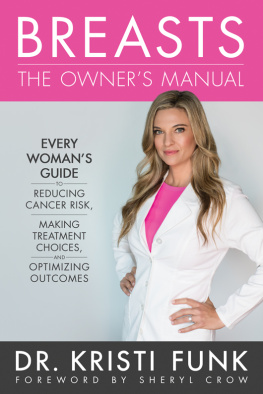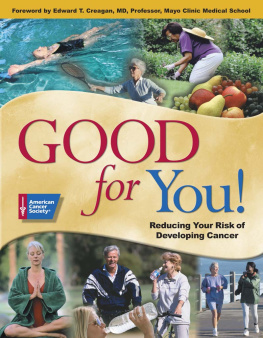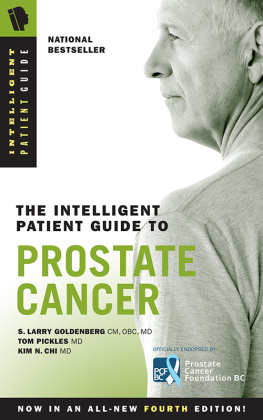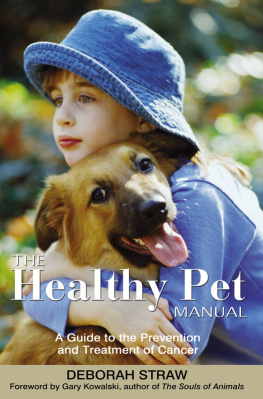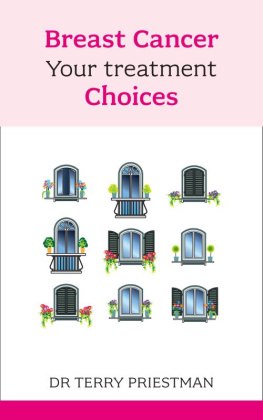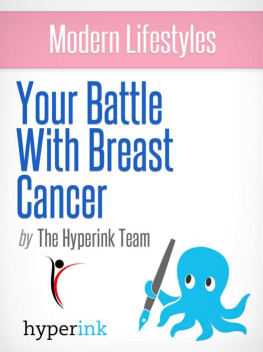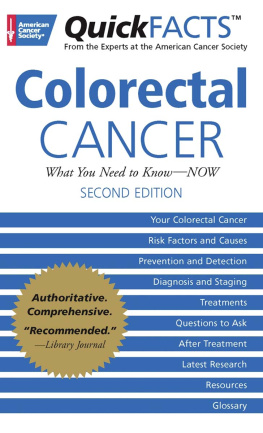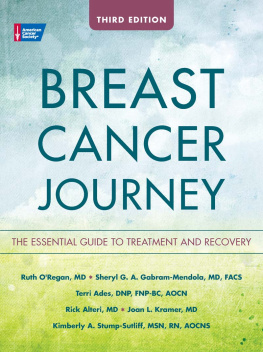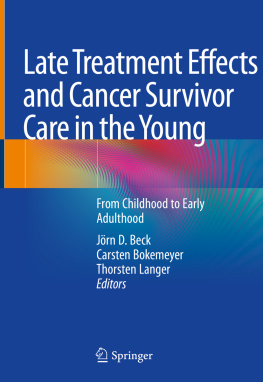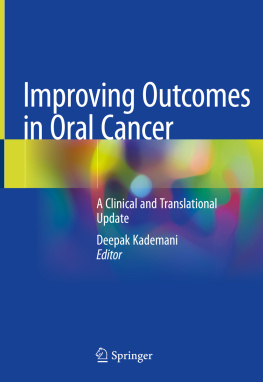Kristi Funk - Breasts: The Owners Manual: Every Woman’s Guide to Reducing Cancer Risk, Making Treatment Choices, and Optimizing Outcomes
Here you can read online Kristi Funk - Breasts: The Owners Manual: Every Woman’s Guide to Reducing Cancer Risk, Making Treatment Choices, and Optimizing Outcomes full text of the book (entire story) in english for free. Download pdf and epub, get meaning, cover and reviews about this ebook. year: 2018, publisher: Thomas Nelson, genre: Romance novel. Description of the work, (preface) as well as reviews are available. Best literature library LitArk.com created for fans of good reading and offers a wide selection of genres:
Romance novel
Science fiction
Adventure
Detective
Science
History
Home and family
Prose
Art
Politics
Computer
Non-fiction
Religion
Business
Children
Humor
Choose a favorite category and find really read worthwhile books. Enjoy immersion in the world of imagination, feel the emotions of the characters or learn something new for yourself, make an fascinating discovery.
- Book:Breasts: The Owners Manual: Every Woman’s Guide to Reducing Cancer Risk, Making Treatment Choices, and Optimizing Outcomes
- Author:
- Publisher:Thomas Nelson
- Genre:
- Year:2018
- Rating:3 / 5
- Favourites:Add to favourites
- Your mark:
- 60
- 1
- 2
- 3
- 4
- 5
Breasts: The Owners Manual: Every Woman’s Guide to Reducing Cancer Risk, Making Treatment Choices, and Optimizing Outcomes: summary, description and annotation
We offer to read an annotation, description, summary or preface (depends on what the author of the book "Breasts: The Owners Manual: Every Woman’s Guide to Reducing Cancer Risk, Making Treatment Choices, and Optimizing Outcomes" wrote himself). If you haven't found the necessary information about the book — write in the comments, we will try to find it.
Kristi Funk: author's other books
Who wrote Breasts: The Owners Manual: Every Woman’s Guide to Reducing Cancer Risk, Making Treatment Choices, and Optimizing Outcomes? Find out the surname, the name of the author of the book and a list of all author's works by series.
Breasts: The Owners Manual: Every Woman’s Guide to Reducing Cancer Risk, Making Treatment Choices, and Optimizing Outcomes — read online for free the complete book (whole text) full work
Below is the text of the book, divided by pages. System saving the place of the last page read, allows you to conveniently read the book "Breasts: The Owners Manual: Every Woman’s Guide to Reducing Cancer Risk, Making Treatment Choices, and Optimizing Outcomes" online for free, without having to search again every time where you left off. Put a bookmark, and you can go to the page where you finished reading at any time.
Font size:
Interval:
Bookmark:
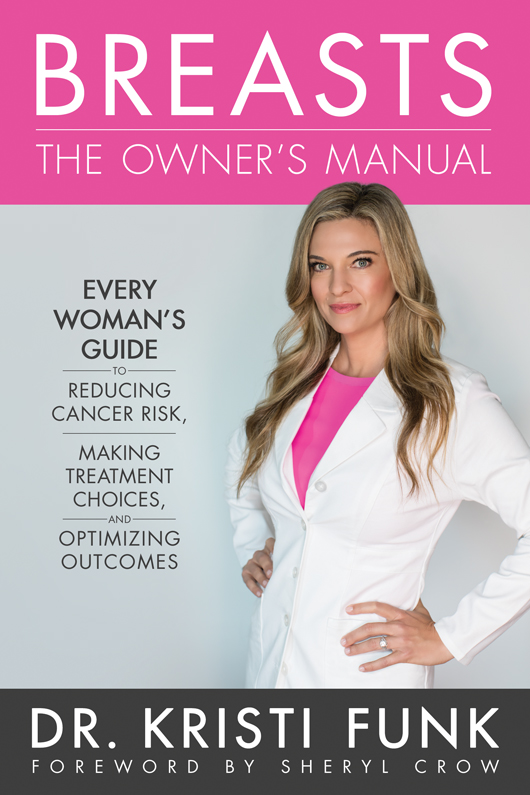
Contents
From the age of four, I wanted to be an actress. (Ha! You thought I was going to say I always wanted to be a doctor, didnt you?) I performed in every school play, beginning with Sleeping Beauty in the second grade and continuing all the way through college, when I starred as Oedipus in an all-female production. Yet Hollywood was never my endgame. I actually pictured myself helping children heal from illness, using drama and imaginative play to explore the feelings and fears brought on by sickness.
Cut to my sophomore year as a psychology major at Stanford University, when I experienced an epiphany that would both change my course and guide it to this day. In the midst of studying for a neuropsychology final, painstakingly trying to memorize which neurotransmitters in the brain led to which functions of the body, I experienced an unmistakable and repetitive interrupting thought that made my own neurotransmitters buzz. It came from God.
Youre going to be a doctor, it said. Whoa.
Okay, that was interesting. Incorrect, but interesting. You see, my female role models married young, and all I wanted was to raise a family and work as a drama therapist. I traveled to Africa a week later on a summer missionary trip that had been planned for months. When I saw firsthand the health challenges that millions of men, women, and children face, my lifes purpose snapped into shapeand not in the form of theater or therapy. I felt newly inspired to care for people in the one way that matters most to themby helping them maintain the very vessel that carries them around all day: their bodies. Disease robs far too many people of joy, replacing hope with chronic illness and death. It isnt right. As I sat cross-legged in a dung hut, balancing potatoes on my head to make the tribal kids laugh, I decided to do something with my life to try to stop the killer of joy: I heeded Gods voice and resolved to become a doctor.
I went to medical school, did my residency in general surgery, and then completed a surgical breast fellowship at Cedars-Sinai Medical Center. I stayed on to become the director of patient education at their breast center, where I gave a number of community and physician lectures. Most women dont want to hear about cancer unless they have it and need to make some decisions, so rather than bore them to tears with medical jargon, I challenged my audiences by discussing attention-grabbing studies that would incite them to alter their behavior. I delved into risk reduction and discovered all sorts of lifestyle game changers. I loved the work, and patients responded like crazy. I couldnt wait to get to the office to spend all day examining and educating women, operating with curative intent, and becoming creative when a diagnosis or cosmetic issue became challenging. Everything I did back then and continue to do todayhelping women boost their health, reduce their breast cancer risk, make sense of a diagnosis, or find their way after treatmentinspired the book youre reading now.
A MULTILAYERED PROBLEM
Whether perky or droopy, full or flat, for two organs perched front and center on half the populations chests, it is pretty crazy that breast health remains rather mysterious to many breast owners. Most women dont know much about their breasts, what their purposes are, and how to keep them healthy so the rest of their bodies can thrive. Everyone knows that breasts can grow cancer, which is the number-one killer of women ages twenty to fifty-nine, yet theres never been a solid and informed conversation about how to reduce our risk factors for this disease and why certain precautions might help.
Any breast health conversation needs to focus on two problems: numbers and knowledge. First and foremost, breast cancer is a pandemic concern, and the numbers sure prove it. In the United States alone, 1 in 8 women will be diagnosed with breast cancer at some point in their lives. Every year, we identify 1.7 million new breast cancer cases worldwide, with over 300,000 in the US. Interestingly, incidence rates vary fourfold across the globe, ranging from 27 per 100,000 in Middle Africa and Eastern Asia, to 93 in the US, to 112 in Belgium, and its not the weather that accounts for these global disparities. If this freaks you out, youre not alone.
Based on my experience as a board-certified breast cancer surgeon who has helped tens of thousands of women navigate breast health issues, I know for a fact that we have the power to reduce our breast cancer risk in achievable and dramatic ways. Enter our second big problem with breast cancer awareness: erroneous public perception. Most women believe that family history and genetics determine who gets breast cancer, but for most people, they dont. Inherited mutations, like BRCA, only cause 5 to 10 percent of breast cancer; in fact, 87 percent of women diagnosed with breast cancer do not have a single first-degree relative with breast cancer.
Ill give you a minute to pick your jaw up off the floor.
For the last thirty years, the medical community has not corrected the false notions held by the majority of breast cancer survivors who attribute their breast cancer entirely to family history, environmental factors, stress, or fateall factors predominantly not under their direct control.
Thats right. You have the opportunity to impact the way you behave toward your breasts and how your breasts respond to that behavior. Rigorous science and firsthand experience in the trenches back up everything I know to be true about breast cancer risk reduction and care. The women I treat are exactly like you. They share your concerns about any new mammogram finding, pain, lump, itch, or discharge. They want to know if theres anything new under the sun that they can do to ward off this disease. Most of the patients who heed my diet, lifestyle, and medical advice come away from our conversations feeling empowered and relieved, gaining clarity over the right thing to do. Depending on the changes they make, women might also notice that their fibrocystic lumps and pain disappear, their obesity or diabetes improves, or they find themselves cancer-free year after year.
I must mention here that having an unhealthy lifestyle doesnt guarantee a future breast cancer diagnosis; similarly, we can never know with certainty that lifestyle choices caused the cancer you might have already had. Moreover, even women following an ideal lifestyle get breast cancer (although not as frequently, as we shall repeatedly see), and boy, are they upset. I did everything right!
That being said, the changes Im about to suggest in this book dont just serve your breasts well. Oh no, ladies. They also yield lower cholesterol, better triglycerides, perfect blood pressure, fewer heart attacks, a leaner body, less diabetes, painless joints, more energy, better sleep, a happier mood, an improved sex life, a sharper mind, less dementia, smoother skin, regular bowel movements, cleaner lungs, less cancer in every single organ in your body, a healthier planet, and a longer life. If you practice what I teach, you will radically reduce, if not completely prevent, many of the illnesses that ultimately lead to chronic and life-threatening diseases. Youll feel a boost of happiness and satisfaction. Youll implement your goals with easeand never look back.
A PIONEERING APPROACH TO BREAST HEALTH
Since I founded the Pink Lotus Breast Center in Los Angeles in 2007 alongside my husband, Andy Funk, our mission has been to fuse state-of-the-art breast cancer screening, diagnosis, and treatment with preventive strategies and holistic, compassionate care. Were out to save lives in a way that eliminates fear, instills confidence, and provides hope in a moment of panic. Pink Lotus aims to transform the delivery of breast health care in America and to help as many women as possible, regardless of their income or status in life. We see thousands of patients every year, with a wide range of concerns, and do our best to accept most insurances, including Medicare. For low-income uninsured or underinsured women, the Pink Lotus Foundation provides 100 percent free breast cancer screenings, diagnoses, treatment, and support to those who otherwise might not be able to receive any care at all.
Font size:
Interval:
Bookmark:
Similar books «Breasts: The Owners Manual: Every Woman’s Guide to Reducing Cancer Risk, Making Treatment Choices, and Optimizing Outcomes»
Look at similar books to Breasts: The Owners Manual: Every Woman’s Guide to Reducing Cancer Risk, Making Treatment Choices, and Optimizing Outcomes. We have selected literature similar in name and meaning in the hope of providing readers with more options to find new, interesting, not yet read works.
Discussion, reviews of the book Breasts: The Owners Manual: Every Woman’s Guide to Reducing Cancer Risk, Making Treatment Choices, and Optimizing Outcomes and just readers' own opinions. Leave your comments, write what you think about the work, its meaning or the main characters. Specify what exactly you liked and what you didn't like, and why you think so.

